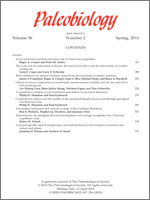Both the body fossils and trackways of sauropod dinosaurs indicate that they inhabited a range of inland and coastal environments during their 160-Myr evolutionary history. Quantitative paleoecological analyses of a large data set of sauropod occurrences reveal a statistically significant positive association between non-titanosaurs and coastal environments, and between titanosaurs and inland environments. Similarly, “narrow-gauge” trackways are positively associated with coastal environments and “wide-gauge” trackways are associated with inland environments. The statistical support for these associations suggests that this is a genuine ecological signal: non-titanosaur sauropods preferred coastal environments such as carbonate platforms, whereas titanosaurs preferred inland environments such as fluvio-lacustrine systems. These results remain robust when the data set is time sliced and jackknifed in various ways. When the analyses are repeated using the more inclusive groupings of titanosauriforms and Macronaria, the signal is weakened or lost. These results reinforce the hypothesis that “wide-gauge” trackways were produced by titanosaurs. It is commonly assumed that the trackway and body fossil records will give different results, with the former providing a more reliable guide to the habitats occupied by extinct organisms because footprints are produced during life, whereas carcasses can be transported to different environments prior to burial. However, this view is challenged by our observation that separate body fossil and trackway data sets independently support the same conclusions regarding environmental preferences in sauropod dinosaurs. Similarly, analyzing localities and individuals independently results in the same environmental associations. We demonstrate that conclusions about environmental patterns among fossil taxa can be highly sensitive to an investigator's choices regarding analytical protocols. In particular, decisions regarding the taxonomic groupings used for comparison, the time range represented by the data set, and the criteria used to identify the number of localities can all have a marked effect on conclusions regarding the existence and nature of putative environmental associations. We recommend that large data sets be explored for such associations at a variety of different taxonomic and temporal scales.
BioOne.org will be down briefly for maintenance on 17 December 2024 between 18:00-22:00 Pacific Time US. We apologize for any inconvenience.
How to translate text using browser tools
1 March 2010
A quantitative analysis of environmental associations in sauropod dinosaurs
Philip D. Mannion,
Paul Upchurch
ACCESS THE FULL ARTICLE

Paleobiology
Vol. 36 • No. 2
March 2010
Vol. 36 • No. 2
March 2010




